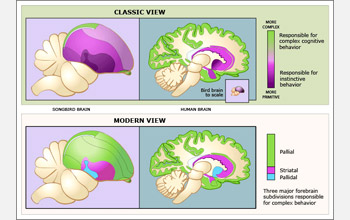Multimedia Gallery
Comparative Views of Avian Brain
A wide range of studies have recently demonstrated that the so-called "primitive" regions of avian brains are actually sophisticated processing regions homologous to those in mammals. The above illustrations compare the traditional view of the primitive avian brain as a subregion of the human brain (in purple) with the new view that the avian brain has subregions proportional to those in humans (blue, purple and green). Scientists now know that the complexities of avian brain regions allow sensory processing, motor control and sensorimotor learning as in the mammalian neocortex (in green).
Projected support for this and other exciting basic research in science, engineering and education was included in the National Science Foundation's (NSF) fiscal year 2006 budget request to Congress. For more current NSF budget information, see NSF Budget Requests to Congress and Annual Appropriations.
This image accompanied NSF press release, "NSF Submits Its Fiscal 2006 Budget Request of $5.6 Billion."
Credit: Zina Deretsky, National Science Foundation
Images and other media in the National Science Foundation Multimedia Gallery are available for use in print and electronic material by NSF employees, members of the media, university staff, teachers and the general public. All media in the gallery are intended for personal, educational and nonprofit/non-commercial use only.
Images credited to the National Science Foundation, a federal agency, are in the public domain. The images were created by employees of the United States Government as part of their official duties or prepared by contractors as "works for hire" for NSF. You may freely use NSF-credited images and, at your discretion, credit NSF with a "Courtesy: National Science Foundation" notation.
Additional information about general usage can be found in Conditions.
Also Available:
Download the high-resolution JPG version of the image. (243 KB)
Use your mouse to right-click (Mac users may need to Ctrl-click) the link above and choose the option that will save the file or target to your computer.

